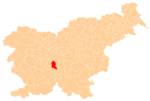Ig, Ig
| Ig | |
|---|---|
 | |
 Ig Location in Slovenia | |
| Coordinates: 45°58′9.09″N 14°32′21.72″E / 45.9691917°N 14.5393667°ECoordinates: 45°58′9.09″N 14°32′21.72″E / 45.9691917°N 14.5393667°E | |
| Country |
|
| Traditional region | Inner Carniola |
| Statistical region | Central Slovenia |
| Municipality | Ig |
| Area | |
| • Total | 12.1 km2 (4.7 sq mi) |
| Elevation | 288.8 m (947.5 ft) |
| Population (2012) | |
| • Total | 2,240 |
| [1] | |
Ig (pronounced [ˈiːk]) is the largest settlement and the seat of the Municipality of Ig, central Slovenia.
Name
The name Ig was first attested in 1249 as Yge (and as Ighe, Iglem, and Iglom in 1261, Yg in 1262, and Hyco and Hyc in 1299). During the Middle Ages, Ig was a regional name, and the settlement now known as Ig was called Studenec until the beginning of the 19th century. The etymology of the name Ig is unclear. It may be connected with the Slovene common noun igo 'yoke' (in reference to the course of the Iška River), or to the Slovene common noun iva 'goat willow' (through borrowing into and then from German), or it may derive from a pre-Slavic substratum.[2]
History
After the Second World War, a Yugoslav labor camp for political prisoners operated in Ig.[3]
.jpg) Postcard of Ig
Postcard of Ig Postcard of Ig
Postcard of Ig.jpg) Postcard of Ig
Postcard of Ig
Landmarks
Parish church
The parish church in Ig is dedicated to Saint Martin and belongs to the Roman Catholic Archdiocese of Ljubljana. It was built in 1780.[4] The painting of Saint Martin in the church is a work by Josip Egartner.[5] A second church, built on Pungrt Hill west of the main settlement, is a 14th-century building, now in ruins. It was dedicated to Saint George.[6]
World heritage site

In the vicinity of Ig, the remains of prehistoric pile-dwelling (or stilt house) settlements, since 2011 protected as part of the Prehistoric Pile dwellings around the Alps UNESCO World Heritage Site.[7][8]
References
- ↑ Statistical Office of the Republic of Slovenia
- ↑ Snoj, Marko. 2009. Etimološki slovar slovenskih zemljepisnih imen. Ljubljana: Modrijan and Založba ZRC, pp. 167–168.
- ↑ Mrvič, Irena. 1999. "Taborišče." Enciklopedija Slovenije, vol. 13 (Š–T), pp. 177–179. Ljubljana: Mladinska knjiga, p. 179.
- ↑ Slovenian Ministry of Culture register of national heritage reference numbers ešd 1848
- ↑ Slovenski biografski leksikon: Egartner Josip (Slovene)
- ↑ Slovenian Ministry of Culture register of national heritage reference numbers ešd 2761
- ↑ UNESCO World Heritage Site - Prehistoric Pile dwellings around the Alps
- ↑ [http://www.ukom.gov.si/en/media_room/newsletter_slovenia_news/news/article/391/2809/1e33cc2ffd/?tx_ttnews[newsletter]=114 "Prehistoric Pile Dwellings Listed as UNESCO World Heritage"]. Slovenia News. Government Communication Office. 28 June 2011.
External links
| Wikimedia Commons has media related to Ig. |
